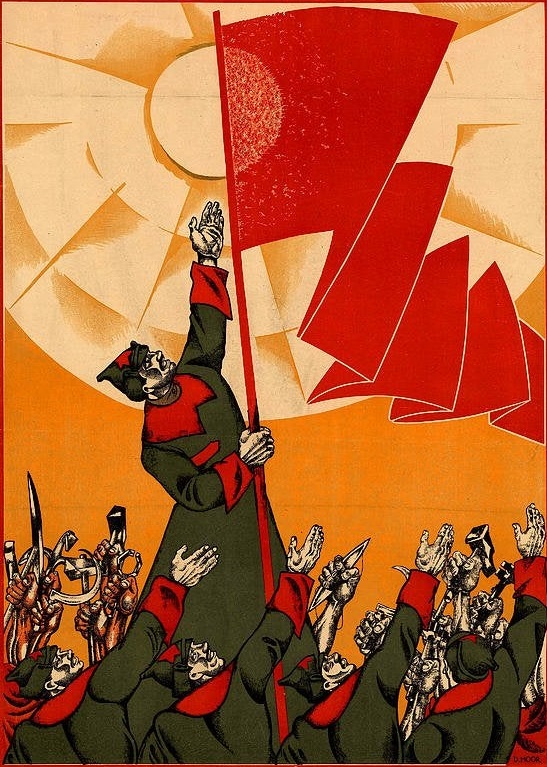If I make art, I would like to get compensated by it. However, under market capitalism, my art has to sell well to make money, which means that I cannot make art out of pure volition, but have to adhere to what consumers like, which may not be in line with what I like. Plus, market capitalism/SnD opens up a whole other can of worms about copyright, piracy, and morality. With an LToV-based system for compensating for art, I will get paid based on how much I worked, rather than if consumers like it or not. In other words, I can allow people to copy and redistribute/remix it without worrying about a loss of customers. To quote George Lucas “[In the USA], you have to adhere to a very narrow line of commercialism”.
I just read the novel Vagabonds by Hao Jingfang which plays with this in the world building and has the characters deal with the topic as well. It’s unfortunately a bit liberal, especially considering the author is Chinese, but I found it quite thought provoking.
While obviously capitalism sucks for art, it’s not clear to me that a LToV-based system would allow you to make the type of art you want to make without consideration of what the people who use the art will value.
deleted by creator
everyone in favor of making Ghost of Faso the leader of the United Socialist States of America?
I don’t know about “leader” but maybe department of labor.
Absolutely, as a professional artist, it is a nightmare. I have to be willing to draw almost anything in order to keep my lights on and all the ideas I have that I want to create, I can’t, because they aren’t profitable, everything needs to be empty, vapid and crowd pleasing, not challenging and thought provoking (or at least, an attempt at that, it would be nice to try at least.)
I fundamentally agree.
There’s something to unpick in relation to the LtoV, though. Value is socially necessary labour time. Does this mean that other people in society would still need to want your art for it to have value according to the LtoV? Is this the theoretical basis for what you observe about needing consumers?
Value is socially necessary labour time.
Important point. I would say that every profession artist in any system would create things for people to see (or hear etc.) and take under consideration what they want to see. Unpopular artists were sidetracked and fired even in socialist states.
There was basically two ways to become a pro then - one was being scouted at amateur contests/exihibits/clubs etc and the second was graduating from an art school. Both involved making art that was popular and/or appreciated by state institutions.
Important point. I would say that every profession artist in any system would create things for people to see (or hear etc.) and take under consideration what they want to see. Unpopular artists were sidetracked and fired even in socialist states.
Exactly, the artist must serve the people. To quote Sergei Prokofiev: “Can the true artist stand aloof from life and confine his art within the narrow bounds of subjective emotion? Or should he not rather be where he is needed most, where his words, his music, and his chisel can help people live a better, finer life?”
All inteligentsia must serve the people.
what does “socially necessary” mean?
Socially necessary labour time roughly means that something must be useful to have value. Commodities are a dialectic of use value and exchange value. Without both, it’s not a commodity. Socially necessary labour time is the average time that it takes to produce the usefulness of a commodity. The more time it takes, on average, the more value it contains.
If value equals labour time, a slow worker would create more value than a faster worker. That can’t be right. So Marx added the ‘socially necessary’.
Imagine that society as a whole creates 40,000 widgets per week. There are several widget factories, totalling 1,000 workers, each working 40 hours. In total, the socially necessary labour time is 40,000 hours per 40,000 widgets, which equals on hour per widget.
A slow worker does not make double the value of the average worker by taking two hours to make one widget. This is because society, as a whole and on average, only needs one hour of labour time. Society is not restricted by one slow worker because the average and faster workers pick up the slack.
Equally, a faster worker does not make half the value of the average worker by making two widgets per hour. Society cannot rely on one fast worker to make all its widgets. However fast they are, one worker can only produce so much. But, if someone develops technology that cuts the labour-time in half, the socially necessary labour-time also halves once the technology becomes widely used.
Marx, Capital vol I, ch 1:
It might seem that if the value of a commodity is determined by the quantity of labour expended to produce it, it would be the more valuable the more unskilful and lazy the worker who produced it, because he would need more time to complete the article. However, the labour that forms the substance of value is equal human labour, the expenditure of identical human labour-power. The total labour-power of society, which is manifested in the values of the world of commodities, counts here as one homogeneous mass of human labour-power, although composed of innumerable individual units of labour-power. Each of these units is the same as any other, to the extent that it has the character of a socially average unit of labour-power and acts as such, i.e. only needs, in order to produce a commodity, the labour time which is necessary on an average, or in other words is socially necessary. Socially necessary labour-time is the labour-time required to produce any use-value under the conditions of production normal for a given society and with the average degree of skill and intensity of labour prevalent in that society. The introduction of power-looms into England, for example, probably reduced by one half the labour required to convert a given quantity of yarn into woven fabric. In order to do this, the English hand-loom weaver in fact needed the same amount of labour-time as before; but the product of his individual hour of labour now only represented half an hour of social labour, and consequently fell to one half its former value.
What exclusively determines the magnitude of the value of any article is therefore the amount of labour socially necessary, or the labour-time socially necessary for its production.[9] The individual commodity counts here only as an average sample of its kind.[10] Commodities which contain equal quantities of labour, or which can be produced in the same time, have therefore the same value. The value of a commodity is related to the value of any other commodity as the labour-time necessary for the production of the one is related to the labour-time necessary for the production of the other.
I mention all this to suggest that if we were to rely on the labour-theory of value to determine the value of art, we might be arguing for a capitalist way of deciding whether and how much value something has.
The LtoV is not a socialist concept but a political economic concept necessary for understanding value. Marx merely refined the formula because Ricardo’s (IIRC, without the ‘socially necessary’ element) could not explain, among other things, why slower workers do not produce more value than faster workers. That situation is logically contradictory but bourgeois political economists couldn’t explain it before Marx.
It seems that seeking compensation for art means seeking to realise exchange value from the production of commodities. Based on the above outline, the LtoV simply gives us the accurate formula for determining that exchange value – it is dialectically related to its use value, which is dialectically related to the socially necessary labour time crystallised within it. If society doesn’t need or want an artefact, it will have no use value, thus no exchange value, and the time spent producing it was socially unnecessary.
If this is right, then the LtoV may not provide a mechanism for improving the compensation of artists. Instead, it explains why artists’s compensation is tied to consumer wants and needs. The problem may be that the LtoV is a concept needed to understand capitalist political economy and so ‘economic’ value. It doesn’t necessarily help us to decide how socialists might want to determine value as it moves away from commodity production.
Still, again, I fundamentally agree with you: the capitalist rationale for producing art, to produce value, should be abolished. To do so, it will be necessary to detach artistic, cultural value from economic value. But that means not doing art for money, which is a problem. It’s hard not to detach art from economic value in capitalism, however, because the natural state is to fetishise commodities and to commodify every relation.
This seems fairly easy to fix in a socialist state. Just have art funds to dedicate towards artistic projects as a use of taxpayer money.
Socially necessary in terms of manual labour pretty much means the average time taken to complete a labour. If the industry standard is that it takes 10 hours to make a coat but you are newbie at it and take 40 hours to make coat, your coat does not have not have more value because you had to invest more time into it. It is used to avoid debunked pitfalls like the mud pie argument.
As art is something which is not mass produced and inturn unique, is it more valuable according to LTV or is it outside the scope of LTV?
For professional artist, deadlines mostly. This don’t change in socialism.









